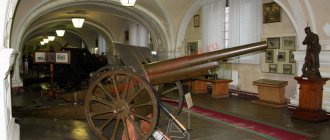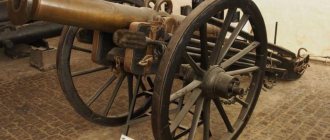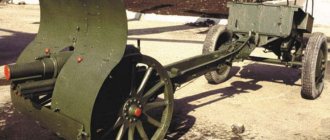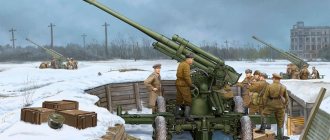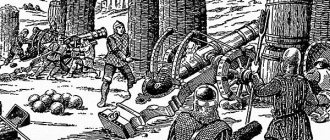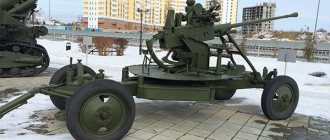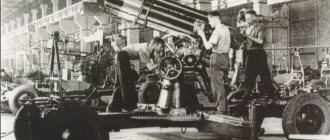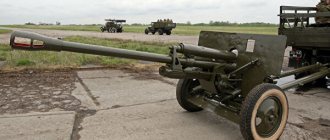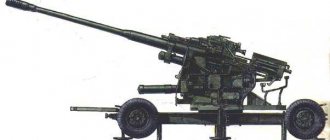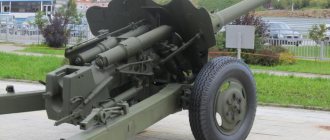76-mm regimental gun mod. 1927 - the first Soviet artillery and Soviet-designed weapon to be mass-produced. A distinctive feature of the design of this gun was that it was aimed at maximizing the cost of production and the use of low-skilled labor. Over fifteen years of production, about 18,000 guns of this type were manufactured. The 76 mm regimental gun of 1927 served as the prototype for several tank and self-propelled artillery guns. The cannon took part in all the wars waged by the Soviet Union at that time, and was in service with several foreign countries.
Combat use.
In the pre-war years, the 76-mm regimental gun of the 1927 model still remained in service, although it was considered a weapon of an outdated design that did not fully meet modern requirements.
In the regimental artillery it was supplemented with a 120-mm mortar - a very effective artillery weapon for mounted fire, partly compensating for the shortcomings of the regimental cannon in the regimental artillery. At the beginning of the war, the Red Army had 4,708 regimental guns. In the western border districts there were 2296 guns and 1675 120-mm mortars. Despite the outdated design at the beginning of the war, the 76-mm regimental gun mod. 1927 showed itself to be quite good; a certain supply of rounds had been accumulated for the gun during the pre-war years, and the shortage affected it to a lesser extent.
The gun satisfactorily coped with the usual tasks of regimental artillery, be it direct fire at the embrasures of firing points or the destruction of enemy personnel. But accompanying infantry battle formations with wheels was made difficult by the significant mass of the gun and the lack of devices for transporting ammunition to the battlefield. Moving a gun behind the infantry in a chain required reinforcement of the crew with infantry.
Actual cannon fire on tanks was effective up to 400 meters. But due to the low initial speed, the armor-piercing projectile destroyed tank armor only up to 30 mm thick. And the shortage of armor-piercing shells was not overcome at the end of 1942. The use of shrapnel with an impact tube was effective only against tanks with the lightest armor. The lack of an automatic shutter (piston bolt) reduced the combat rate of fire to 10 rounds per minute.
The single-beam machine provided a horizontal firing angle of only five degrees and significantly limited the fire mobility of the gun. Effective fire when firing a high-explosive fragmentation grenade at enemy fire weapons and manpower from a closed firing position is up to 4000 meters, and direct fire - 1500 meters. Average shell consumption when firing direct fire, at a range of 600-1200 meters: destruction of light field shelters - 15-20 high-explosive grenades; to destroy an open firing point - 8-12 fragmentation grenades within 10-15 minutes.
Largely thanks to the simplicity of the design and the enormous losses of the material part, for the first time during the months of the war, its production, which was stopped in 1940 in order to find a more advanced design for the regimental gun, was able to be restored in besieged Leningrad.
Stories about weapons. "Regiments." 76-mm regimental guns of the 1927 and 1943 model
In this material we will talk about regimental guns of the 1927 and 1943 models, the difficult work of which fell on the forefront of more than one conflict and the Great Patriotic War. It was these guns that took on the entire load as the main infantry support weapon.
76-mm regimental gun model 1927.
Soviet light regimental gun of 76.2 mm caliber for direct support of infantry and cavalry. “Colonel”, “snub-nosed”, “bobby”.
The first Soviet large-scale artillery gun. The gun was produced en masse (more than 18 thousand guns were produced) from 1928 to 1943, and took part in the fighting in Khasan, Khalkhin Gol, the Polish campaign of 1939, the Soviet-Finnish and the Great Patriotic War.
The main task of the gun, which was located in infantry combat formations, was to quickly suppress enemy firing points both in defense and on the offensive, following the attackers.
The gun served as a prototype for the creation of the first domestic serial tank guns (“76-mm tank gun model 1927/32” on the T-28 tank) and self-propelled guns (SU-12 self-propelled guns) of medium caliber.
The gun was quite conservative in design, overly heavy, and had insufficient horizontal aiming sector and armor penetration (before the introduction of the cumulative projectile). The creation of a gun based on not the newest models had an impact.
When the decision was made to create a regimental gun in 1924, the 76-mm gun of the 1902 model was in service.
The main disadvantages of the 1902 model gun were its excess weight (1350 kg in combat position and 2380 kg in stowed position) and low mobility.
Considering the engineering difficulties in the Soviet Union at that time, it was decided to abandon the design of the gun “from scratch”, creating a gun based on existing samples.
Several models were considered as prototypes, but the 76-mm gun of the 1913 model, the so-called “short three-inch gun,” was taken as the starting point.
The design of the new gun was completed by the end of 1925, at the beginning of 1926 a prototype of the gun was manufactured, at the beginning of 1928 the gun was adopted by the Red Army under the official name “76-mm regimental gun mod. 1927."
All work was entrusted to the Artillery Technical Office (ATK) of the Putilov Plant, where mass production of guns began.
From 1929 to 1934, the gun was subject to constant modifications. Their goal was to simplify the design and increase the manufacturability of production, as well as improve the tactical and technical characteristics. Work to modernize the gun was carried out at the ATK Putilov plant under the leadership of A. A. Monakov and I. A. Makhanov.
In 1929, some changes and simplifications were introduced into the design of the bolt; in 1930, the fastened barrel was replaced with a monoblock; in the same year, a new metal wheel with rubber tires was developed for the gun, which made it possible to increase the maximum speed of cannon transportation to 25 km/h . However, it was possible to completely replace the old version with wooden wheels in production only by 1934.
76-mm regimental gun mod. 1927 had a number of disadvantages, including a small vertical guidance angle and low armor penetration. Despite the fact that at that time most tanks were protected by bulletproof armor 10-20 mm thick, the low initial velocity of the projectile did not allow them to successfully fight armored vehicles.
The 30 mm armor of German tanks (the front of the light and the side of the medium) was at the limit of the gun's ability to penetrate even at short distances.
The situation was somewhat corrected by the adoption of a 76-mm cumulative projectile into service in 1942, but by that time it had already become clear that, if not the creation of a new weapon, then a radical modernization was required.
The gun crew consisted of 7 people: a gun commander, a gunner, a loader, a lock man, a correct man (a crew member who turned the gun in accordance with the gunner’s instructions) and two box men (carriers).
The gun was carried by four horses, another four were required to transport the charging box. Mechanical traction could also be used - Pioneer, Komsomolets tractors, cars.
But in combat conditions, the crew often had to cope with transporting the gun.
Gun limbers were used for transportation. Each limber contained six trays of 4 shots. The charging box consisted of forward and reverse passages. The forward stroke was generally similar to the limber and also accommodated 6 trays of 4 shots. The rear passage was somewhat larger and accommodated 8 trays of 4 shots each. Thus, the ammunition carried was 80 rounds (24 in the front, 24+32 in the forward and rear passages of the charging box).
In 1943, the gun was discontinued, but until the end of the war it continued to be one of the main artillery systems of the Red Army. An interesting feature of the gun was its air transportability, which turned out to be in demand in practice - in besieged Leningrad at the end of 1941, 457 pieces of 76-mm regimental guns were manufactured, which were delivered to Moscow by plane and provided significant assistance to Soviet troops in the Battle of Moscow.
76-mm regimental gun mod. 1927 was intended to solve the following problems:
for direct support and escort of infantry; to combat armored vehicles and tanks; to suppress and destroy enemy infantry fire weapons located openly and behind light field shelters; to suppress and prohibit all types of fire from bunkers (bunkers) by direct fire at embrasures; for making passages in wire fences and passages in grooves for their tanks.
The gun was intended almost exclusively for direct fire. During the offensive, regimental guns had to move as a crew in the combat formations of the advancing infantry and quickly suppress enemy fire weapons that impeded the advance - machine gun nests, artillery pieces and mortars, and various firing points.
In defense, the guns also had to be in infantry combat formations, firing at the advancing enemy infantry, and, if necessary, at tanks and armored vehicles.
The specificity of the actions of regimental guns led to large losses of both material and crews, but at the same time, along with battalion artillery (45-mm cannons) and mortars, regimental guns were the only artillery systems that were located directly in battle formations and had the ability to maximize quickly hit identified targets.
Due to their relatively small size and weight, regimental guns were actively used during river crossings, landing operations, and in urban battles.
Characteristics:
Caliber, mm: 76.2 Crew, people: 7 Rate of fire, rds/min: 10—12 Carriage speed on the highway, km/h: 25 Height of the firing line, mm: 945
Weight in stowed position, kg: 1620 (with front end and servants) Weight in combat position, kg: 740-780 kg (on wooden wheels), 903-920 kg (on metal wheels)
Firing angles Vertical aiming angle, degrees: from −5.6 to +24.5° Horizontal aiming angle, degrees: 5.5°
The small maximum elevation angle of the gun greatly limited the firing range. However, the firing tables indicate the maximum range at an elevation angle of 40° - to fire at such an elevation angle, it was necessary to tear off a special trench under the trunk part of the machine, which required significant time to prepare the firing position and made it difficult to maneuver with fire, but made it possible to fire at distant targets.
Another feature of the “regiment” was a very impressive set of ammunition.
Armor-piercing shells: UBR-353A, UBR-353V, UBR-353SP. Firing range up to 4,000 m. HEAT shells: UBP-253A (since 1943), UBP-353M (since 1944). Firing range up to 1,000 m. High-explosive fragmentation shells: UOF-353A, UOF-353AM, UOF-353M. Firing range up to 8,500 m. Old-style high-explosive grenades: UV-353, UV-353M, UV-353F. Firing range up to 6,700 m.
76-mm regimental gun model 1943.
Developed in 1942-1943 under the leadership of M. Yu. Tsirulnikov. This gun replaced the 76-mm regimental gun of the 1927 model and was actively used at the final stage of the Great Patriotic War.
A total of 5,192 guns of this type were built in 1943-1946, which were in service with the Soviet Army in the post-war period until the end of the 50s, when they were replaced by more modern systems.
Tsirulnikov proposed placing a 76-mm cannon barrel of the 1927 model on the carriage of a 45-mm M-42 anti-tank gun of the 1942 model. This solution made it possible to obtain a fairly light artillery system using well-proven elements in production.
The new system turned out to be almost a third lighter than the 1927 model gun, the horizontal aiming angle increased significantly, the overall dimensions decreased, but armor penetration, maximum firing range and rate of fire remained the same.
Initially, the new gun was accepted by the commissions without enthusiasm, however, with the advent of cumulative projectiles in 1943, which made it possible not to worry too much about the initial velocity of the projectile and guarantee penetration of armor up to 70 mm thick at medium distances, Tsirulnikov’s development was remembered again. Moreover, in comparison with other existing projects, it was practically a finished and perfected product. So the gun was put into service under the designation OB-25.
Characteristics:
Caliber, mm: 76.2 Crew, people: 6 Rate of fire, rds/min: 12 Carriage speed on the highway, km/h: up to 35 Weight in stowed position, kg: 1300 (with limber) Weight in firing position, kg: 600 Angle VN, degrees: from −8 to +25° Angle GN, degrees: 60°
Compared to the 76-mm regimental gun of the 1927 model, the range of OB-25 ammunition was not rich and included only 4 types of shells. OF-350 high-explosive fragmentation shells and O-350A fragmentation shells were used to fire at enemy personnel, fire weapons and fortifications.
There were two types of cumulative shells: steel BP-350M (armor penetration up to 100 mm) and steel cast iron BP-353A (armor penetration about 70 mm). Both projectiles were equipped with an instant-action BM fuse.
No armor-piercing shells were produced for the Ob-25.
Compared to its predecessor, the 76-mm regimental gun of the 1927 model, the OB-25 significantly benefits in mobility (less gun mass and higher transport speed) and horizontal guidance angle (which gives better opportunities for fire maneuvers and fighting tanks), but inferior in maximum range and accuracy of fire.
True, many experts, making comparisons, noted that a long firing range for a regimental gun, intended primarily for firing at targets located in the line of sight of the crew, is not a significant advantage.
Despite the shortcomings it inherited from its ancestor, the OB-25 cannon had one incomparable advantage - a very light weight for its caliber. This made it possible to provide direct support to infantry on the battlefield, and quickly switch to suppressing field fortifications, as well as effectively fight enemy light/medium tanks using cumulative ammunition.
In general, the “regiments” played a very significant role in the Great Patriotic War. Together with 82 mm and 120 mm mortars and a 45 mm anti-tank gun, these guns were the main infantry assistants on the front line.
Today these guns can be found in our country as exhibits, although they are not as common as the 76-mm divisional gun. But this in no way detracts from their enormous contribution to the Victory.
The guns in the photographs belong to the Museum of Military History in Padikovo, Moscow Region.
Literature
- A. B. Shirokorad.
Encyclopedia of domestic artillery. - Mn.: Harvest, 2000. - 1156 p.: ill. With. — ISBN 985-433-703-0. - A. B. Shirokorad.
The genius of Soviet artillery: the triumph and tragedy of V. Grabin. - M.: AST, 2002. - 432 pp.: 24 l. ill. With. — ISBN 5-17-013066-X. - A. B. Shirokorad.
God of War of the Third Reich. - M.: AST, 2002. - 576 pp.: 32 l. ill. With. — ISBN 5-17-015302-3. - A. Ivanov.
USSR artillery in World War II. - St. Petersburg: Neva, 2003. - 64 p. — ISBN 5-7654-2731-6. - Shunkov V.N.
Weapons of the Red Army. - Mn.: Harvest, 1999. - 544 p. With. — ISBN 985-433-469-4. - Artillery / under general ed. Marshal of Artillery M. N. Chistyakov. - M.: Military Publishing House of the USSR Ministry of Defense, 1953.
- Efimov M. G.
Course of artillery shells. - M.-L.: Oborongiz NPO USSR, 1939. - Kozlovsky D. E.
Material part of artillery. - M.: Oborongiz NKO USSR, 1939. - Collection of research and materials from the Artillery Historical Museum. Issue IV / ed. regiment. Ermoshina I.P. - L.: AIM, 1959.
- Nikolaev A. B.
Battalion artillery. - M.: Oborongiz NKO USSR, 1937. - Paulaharju Jyri.
Itsenäisen Suomen Kenttätykit 1918-1995 (Field guns in Finland 1918-1995). - Helsinki: Sotamuseo, 1996. - 184 p. — ISBN 951-25-0811-7. - Service manual for 76 mm gun mod. 1942
USV abroad, conversion to 7.62 cm FK 39
In 1941-1942, the Germans captured a significant number of USV guns and assigned them the designation 7.62 cm FK297(r)
.
Most of the captured guns were converted by the Germans into field ones, with a barrel modeled after the 7.62 cm Pak 36
.
The upgraded gun was named 7.62 cm FK 39
.
A muzzle brake was installed on the gun, and the chamber was bored out for ammunition from 7.62 cm Pak 36
.
The weight of the gun was, according to various sources, 1500-1610 kg. The exact number of guns converted in this way is unknown, since in German statistics they were often combined with the Pak 36. According to some sources, up to 300 of them were produced. The ballistic characteristics of the gun are also unknown; according to the results of tests of a captured gun in May 1943, an armor-piercing projectile fired from it pierced the 75-mm frontal armor plate of a KV tank at an angle of 60 degrees at a distance of 600 m.
By March 1944, the Germans still had 359 of these guns, of which 24 were in the East, 295 in the West, and 40 in Denmark.
| 7.62 cm FK39 | 76 mm FK 39 field gun in the Sofia Military Museum. | Trophies captured by the Allies in Normandy. | Trophies captured by the Allies in Normandy. |
Changes made to the design during mass production
The first series guns had wooden wheels; the speed of towing a gun on good roads did not exceed 15 kilometers per hour. Since the ancestor of the 76-mm regimental gun of 1927 was the mountain gun of 1909, it inherited a collapsible barrel from it. The production technology for such barrels is quite complex and, as a result, expensive. But since there was no need for a detachable barrel for a regimental gun, and they didn’t want to change the production technology, they began to connect the casing and pipe in a hot state, which led to the fact that the barrel became impossible to disassemble. The technology for producing cheaper barrels - monoblocks - was mastered only in 1930.
Technical data of the 76-mm regimental gun mod. 1927
| Caliber, mm | 76,2 |
| Projectile weight, kg | 6,23-6,3 |
| Initial projectile speed, m/s | 387-370 |
| Vertical guidance angle | +25 -6° |
| Horizontal firing angle | 6° |
| Weight in firing position, kg | 900 |
| Weight in stowed position, kg | 1620 |
| Rate of fire, rds/min | 10-12 |
| Maximum firing range, m | 8500 |
| Direct shot range, m | 440 |
Nomenclature of ammunition and armor penetration table.
(76-mm regimental gun model 1927. Firing tables. M, GAU. 1943)
The design of the gun was considered insufficiently modern. And in 1938, an order was issued to design a regimental gun with sliding frames and an elevation angle increased to 65 degrees. Moreover, the weight of the gun should not exceed 800 kg.
In pre-war times, the production of 76-mm regimental guns of 1927 was concentrated at the Putilov plant. In 1942, plant number 172 took over the production baton. With the development of production of the 76-mm regimental gun of 1943, the production of 76-mm regimental guns of 1927 was discontinued.
| Release of 76-mm regimental guns mod. 1927 to 1938-43 | ||||||
| Type of gun | 1938 | 1939 | 1940 | 1941 | 1942 | 1943 |
| 76-mm regimental gun model 1927. | 1000 | 1300 | 900 | 3918 | 6809 | 2555 |
Search for a new design.
Despite the simplicity of design and maintenance, the low price of the gun was still not entirely satisfactory to the military. In 1942, German tanks increased their armor and against this background the regimental guns already looked downright weak. Therefore, already in the spring of 1942, a competition was announced for the modernization of the regimental gun. The main tasks were:
- increasing the thickness of pierced armor to 55 mm at a distance of half a kilometer;
- the greatest possible unification of the components of the regimental gun with other serial guns;
- reducing the weight of the gun, which should not have exceeded nine hundred kilograms in firing position;
Two projects were submitted to the competition:
- Grabinskaya ZIS-21, which essentially represented a serial ZIS-3 cannon with a barrel shortened to 20 calibers and a modified shield closure
- Project of the Kirov plant, in which the barrel of a 76-mm cannon mod. 1927 was lengthened by nine calibers and balanced with a weight welded to the breech
Both projects were rejected. The ZIS-21 not only did not meet the required performance characteristics in terms of weight, but even surpassed the production gun in this indicator. In addition, during testing, the gun demonstrated a recoil that exceeded the value provided for in the technical specifications. When firing, the Leningrad cannon showed itself to be better than its competitors' cannon, but it also did not suit the military.
Production
Serial production of the USV began in 1939 at plant No. 92. That year, 140 guns were produced, in 1940 - 1010. At the beginning of 1941, the USV was discontinued. This decision was explained by two reasons: firstly, the mobilization plan for divisional guns was fully implemented (the mobilization reserve on June 1, 1941 was 5,730 guns, but 8,513 guns were available); secondly, it was planned to switch to divisional guns of a larger caliber (the 107-mm divisional gun of the 1940 model (M-60) had already been put into mass production).
However, this reserve was not sufficient. Soon after the start of the war, the head of the Main Artillery Directorate (GAU), Marshal G.I. Kulik, reported that there were no divisional guns in the GAU warehouses, and for the formation of new units they could only be obtained from weapons factories [ source not specified 3217 days
].
With the beginning of the war, according to the mobilization plan, the production of SPM was again expanded to. In 1941, 2616 guns were produced, in 1942 - 6046 of these guns. According to the State Defense Committee Decree No. 955ss dated November 23, 1941 “On the plan for the production of 45 mm anti-tank guns and 76 mm divisional guns (USV) for December 1941, January and February 1942” by factories No. 221 and No. 92 in total should have been produced in December: 1150 units, in January: 1300 units, in February: 1650 units. Also, Plant No. 92 was allowed to use the existing reserves for the ZIS-2 cannon by placing no more than 1000 USV barrels on the ZIS-2 carriages. Production of the USV was discontinued at the end of 1942 due to the adoption of the new ZIS-3 divisional gun, which had a number of advantages over the USV. It is worth noting that the displacement of the USV from production occurred gradually, in particular, plant No. 92 continued to produce the USV in 1942 (706 guns were produced), although at the end of the summer of 1941 the ZIS-3 was already produced at this plant.
76-mm regimental gun "OB-25" mod. 1943
76-mm regimental gun "OB-25" mod. 1943
Part I With the beginning of the Great Patriotic War, serial production of the 76 mm regimental gun mod. 1927, discontinued in 1940. This weapon was created on the basis of a 3-inch mountain gun mod. 1909, was considered obsolete by the mid-30s. The main disadvantages of the gun included low elevation and horizontal angles, low rate of fire due to the use of a piston bolt in the design of the gun and, as a consequence, the lack of a semi-automatic mechanism, insufficient towing speed, low initial projectile speed, poor armor penetration and large combat weight. In the pre-war years, the design bureaus of several artillery factories attempted to develop a project for a new regimental gun, but for various reasons, not one of them was brought to mass production. By the beginning of 1942, it became obvious that the 76 mm regimental gun mod. 1927 cannot meet the needs of rifle and cavalry units for fire support due to the listed shortcomings. The inability to use the gun as an effective anti-tank weapon caused a lot of criticism among the troops. In March 1942, the GAU of the Red Army approved new tactical and technical requirements (TTT) for the design of a new 76 mm regimental gun. Based on their contents, the new gun had to have a combat weight of no more than 900 kg, the initial flight speed of the projectile had to provide armor penetration of at least 50 mm at a distance of up to 500 m, in addition, when designing the gun, components and mechanisms mastered in production had to be used artillery factories. The design bureau of the Kirov plant (St. Petersburg), the design bureau of plant No. 92 (Nizhny Novgorod) and the design bureau of plant No. 172 (Perm, Motovilikha) were involved in the creation of the new system. The design team of the artillery design bureau of the Kirov plant took the path of modernizing the existing gun mod. 1927, which consisted of increasing the barrel length by 9 calibers, installing an inert weight under the breech to balance the swinging part of the gun, and minor alterations in the design of recoil devices. Military tests of prototypes of the 76 mm regimental gun mod. 1927/42 took place in the summer of 1942 among the troops of the Leningrad Front and were considered unsuccessful. The design bureau of plant No. 92 created a 76 mm regimental gun under the factory name (index) ZIS-21-11, the design of which was the design of a 76 mm ZIS-3 divisional gun with a barrel shortened to 20 calibers. The gun was tested in May 1942 at the Gorokhovets training ground (NIAP, Nizhny Novgorod region), during which the unreliable operation of the fire starter and unsatisfactory armor penetration were revealed.
Continued here:
Characteristics and properties of ammunition
The USV could use all ammunition of Russian divisional and regimental artillery since 1900. HEAT shells were used mainly in regimental artillery rounds (until the end of 1944, their use in divisional guns was prohibited due to the imperfection of the fuse and the risk of the shell exploding in the barrel). The penetration of a cumulative projectile is about 70 mm (according to other sources, 100 mm at an angle of 90° and 60 mm at an angle of 60°). Until 1942, due to a shortage of armor-piercing shells, it was recommended to use shrapnel placed “on impact” when firing at tanks. Armor penetration was about 30 mm.
| Ammunition nomenclature | |||||
| Type | GAU index | Projectile weight, kg | Explosive weight, g | Initial speed, m/s | Table range, m |
| Caliber armor-piercing shells | |||||
| Blunt-headed with ballistic tip tracer | 53-BR-350A | 6,3 | 155 | 662 | 4000 |
| Blunt-headed with ballistic tip with tracer localizers | 53-BR-350B | 6,5 | 119 | 655 | 4000 |
| Blunt-headed solid tracer with a ballistic tip (BR-350B solid) | 53-BR-350SP | 6,5 | No | 655 | 4000 |
| Sub-caliber armor-piercing shells | |||||
| “Reel” type (adopted into service in April 1943) | 53-BR-354P | 3,02 | No | 950 | 500 |
| HEAT shells | |||||
| Steel cast iron rotating (in the army from May 1943 - for regimental guns, from the end of 1944 - for divisional guns) | 53-BP-350A | 5,28 | 623 | 355 | 500 |
| High-explosive fragmentation shells | |||||
| Steel Long Range Grenade | 53-OF-350 | 6,2 | 710 | 680 | 13 290 |
| Steel cast iron long range fragmentation grenade | 53-О-350А | 6,21 | 540 | 680 | 10 000 |
| High explosive | 53-OF-350V | 6,2 | ? | ? | ? |
| High-explosive small-scale fragmentation | 53-OF-363 | 7,1 | ? | ? | ? |
| High explosive steel old Russian grenade | 53-F-354 | 6,41 | 785 | 640 | 9170 |
| High explosive steel old Russian grenade | 53-F-354M | 6,1 | 815 | ? | ? |
| High explosive steel old French grenade | 53-F-354F | 6,41 | 785 | 640 | 9170 |
| Shrapnel | |||||
| Shrapnel with tube 22 sec. or D | 53-Sh-354 | 6,5 | 85 (260 bullets) | 624 | 6000 |
| Shrapnel with T-6 tube | 53-Sh-354T | 6,66 | 85 (250 bullets) | 618 | 8600 |
| Hartz shrapnel with capes | 53-Sh-354G | 6,58 | 85 | ? | ? |
| Rod shrapnel (a projectile from a 3-K anti-aircraft gun model 1931 with the lower drive belt removed or ground off) | 53-Sh-361 | 6,61 | No | 666 | 8400 |
| Buckshot | |||||
| Buckshot | 53-Sh-350 | ? | 549 bullets | ? | 200 |
| Smoke shells | |||||
| Smoke long-range steel | 53-D-350 | 6,45 | 80 TNT + 505 yellow phosphorus | ? | ? |
| Smoke steel cast iron | 53-D-350A | 6,45 | 66 TNT + 380 yellow phosphorus | ? | ? |
| Incendiary shells | |||||
| Incendiary long-range steel | 53-З-350 | 6,24 | 240 | 679 | 9400 |
| Incendiary | 53-З-354 (drawing 3890) | 6,5 (6,66) | 240 | 624 | 6200 |
| Incendiary Pogrebnyakov - Stefanovich | 53-З-354 | 4,65 | 240 | 680 | 5600 |
| Chemical fragmentation shells | |||||
| Chemical fragmentation projectile | 53-OX-350 | 6,25 | ? | 680 | 13 000 |
| Armor penetration table for the 76-mm divisional gun mod. 1939 (USV) | ||
| Blunt-headed caliber armor-piercing projectile 53-BR-350A | ||
| Range, m | At a meeting angle of 60°, mm | At a meeting angle of 90°, mm |
| 100 | 65 | 80 |
| 300 | 60 | 75 |
| 500 | 55 | 70 |
| 1000 | 50 | 60 |
| 1500 | 45 | 50 |
| Sub-caliber projectile 53-BR-354P | ||
| Range, m | At a meeting angle of 60°, mm | At a meeting angle of 90°, mm |
| 100 | 95 | 120 |
| 300 | 85 | 105 |
| 500 | 75 | 90 |
| The data given refers to the Soviet method for measuring penetration power. It should be remembered that armor penetration indicators can vary noticeably when using different batches of shells and different armor manufacturing technologies. |
76-mm divisional gun ZiS-3 model 1942
HISTORY OF CREATION. Soviet semi-automatic 76 mm caliber gun on a towed wheeled carriage. 76-mm divisional gun mod. 1942 ZiS-3 (GAU index 52-P-354U) was put into service on February 12, 1942 and became the most popular Soviet artillery gun produced during the war. It was actively used in anti-tank artillery units.
In Soviet artillery units she received the nickname “Zosya”.
German soldiers gave the cannon their nickname "Ratsch, Boom", in which the word "Ratsch" denoted the sound of hitting the target, and only then the sound of the Boom cannon firing is heard. Production of 76-mm ZiS-3 divisional guns in 1942-1945.
| Manufacturing plants | 1942 | 1943 | 1944 | 1945 |
| № 92 | 10139 | 12269 | 13215 | 6005 |
| № 235 | — | 1655 | 2899 | 1820 |
| No. 7 "Arsenal" (Leningrad) | — | — | 14 | — |
| Total: | 10139 | 13924 | 16128 | 7825 |
PHOTOS of wartime guns.
PHOTOS of guns from museums:
- Photos of the 76-mm divisional gun mod. 1942 (ZIS-3) from the Museum of Artillery, Engineering Troops and Signal Corps. Ministry of Defense of the Russian Federation. (link)
DESIGN and performance characteristics.
ZiS-3 is a gun of a modern design for that time. The gun barrel is a monoblock, with a breech and a muzzle brake (absorbing about 30% of the recoil energy). The shutter is vertical wedge, semi-automatic. Semi-automatic shutter of mechanical (copier) type. Push-button or lever release (on guns of various production series). The barrel life of guns in the first series is 5,000 rounds, and for most guns it is 2,000 rounds. When fired, anti-recoil devices roll back with the barrel and consist of a hydraulic recoil brake and a hydropneumatic knurler. The rollback is permanent. The lifting mechanism has two sectors. Screw type rotary mechanism. The handles for the lifting and rotating mechanisms are located to the left of the barrel, which greatly facilitates the gunner’s work when shooting at moving targets. The balancing mechanism is spring-type, pulling, and consists of two columns. The combat axis is straight. The gun is sprung, the springs are in the column. The wheels are metal, with rubber tires, close to those of the GAZ-AA car (with a different hub shape). To protect the crew, the gun had a 5 mm thick shield. The gun is equipped with a panoramic sight (guns aimed at anti-tank artillery are equipped with direct-fire sights PP1-2 or OP2-1). To be moved by horse traction, the ZiS-3 is equipped with a unified front end mod. 1942 for regimental and divisional guns.
Caliber - 76.2 mm. Copies - 48016 pieces. (1941/1942-1945) Calculation - 6 people. Rate of fire - up to 25 rounds/min. Carriage speed on the highway - ??? km/h
Barrel: Barrel length - 40 klb. (including the muzzle brake), according to other data 39.3 klb. (excluding muzzle brake).
Weight: Weight in stowed position - 1850 kg. Weight in combat position - 1116 kg.
Dimensions in stowed position: Length - 6095 mm. Width - 1645 mm. Height - ??? mm. Clearance - ??? mm.
Firing angles: VN angle - from −5 to +37° GN angle - 54°
AMMUNITION. Indices of shells used for the ZiS-3 gun:
- OF-350 high-explosive fragmentation steel grenade with KTM-1 or KTMZ-1 fuse.
- O-350A steel cast iron fragmentation grenade with KTM-1 fuse.
- D-350 smoke steel projectile with KTM-2 fuse.
- D-350A steel cast iron smoke projectile with KTM-1 fuse.
- Z-350 Incendiary steel projectile with T-6 tube.
- Sh-354T Shrapnel bullet with T-6 tube.
- Sh-354 Shrapnel bullet with a 22-second tube.
- BR-350A Armor-piercing tracer projectile with an MD-5 or MD-7 fuse.
- BR-350B Armor-piercing tracer projectile with an MD-6 or MD-8 fuse.
- BR-354P Sub-caliber armor-piercing tracer projectile.
- BP-350M Armor-piercing steel projectile with BM fuse.
- Shch-350 Buckshot.
COLORING OF THE GUN. The guns were standardly painted (since 1938) in protective green color 4BO, with thick oil paints. They are diluted with natural drying oil, as indicated by the letter O in the abbreviation of the paint name. From the 1930s until 1938, the color ZB was used. Color 4BO was prepared from three pigments: green chromium oxide, Zhuravskaya ocher and crown orange. Camouflage painting was also used. In winter, white paint was applied over the “summer color”. Instead of paint, compositions based on lime and chalk were also used. White cloth could also be hung on the cannon.
More details can be found in the instructions for camouflage painting of material in summer and winter conditions from the Engineering Directorate of the Red Army, issued in 1940 - Open the instructions in .pdf.
Literature/useful links:
- Service manual for the ZiS-3 gun mod. 1942 USSR Ministry of Defense. 1971 (link to file in DjVu format)
- Drawings of the 76-mm divisional gun ZiS-3 (open in pdf)
- Management. Ammunition for 76 mm ground, tank and self-propelled artillery guns. 1949 (link to file in DjVu format)
- Album of unitary cartridges and their elements for 76-mm guns of ground, tank and self-propelled artillery (link to file in DjVu format).
- Article in M. Hobby magazine November 9, 2006 (open in pdf)
- Photos of the 76-mm divisional gun mod. 1942 from the Museum of Artillery, Engineers and Signal Corps. Ministry of Defense of the Russian Federation. (link)
- Schemes - (link No. 1) (link No. 2)
- Article on wikipedia (link)
- Artwork from user kvserg - link
Organizational and staffing structure
There was a light artillery regiment consisting of a division of 76-mm guns (three batteries of four guns each) and two mixed divisions (two batteries of 122-mm howitzers and one battery of 76-mm guns). In total, the division had twenty 76-mm divisional guns. In July 1940, the 76-mm gun division was eliminated, leaving only eight guns in the division. In March 1942, a third division was added from a battery of 76 mm guns and a battery of 122 mm howitzers, making twelve guns.
In the guards rifle divisions, since December 1942, the artillery regiment had three divisions of two batteries of 76-mm guns (twenty-four guns). In December 1944, a new staff of guards rifle divisions was introduced, introducing an artillery brigade of three artillery regiments, including light artillery (20 guns). In June 1945, all rifle divisions were transferred to this state.
Since 1939, rifle brigades also had eight divisional guns, and motorized rifle and mechanized brigades had twelve guns.
The motorized division also had eight divisional guns in 1939-1941.
In 1939-1941, cavalry divisions also had 8 divisional guns; from August 1941 to the summer of 1942, cavalry divisions had no artillery. In the summer of 1942, eight 76-mm divisional guns again appeared in the cavalry divisions.
Since the second half of 1942, the cavalry corps had an artillery division (twelve guns). 76-mm guns appeared in tank and artillery corps at the end of 1944 (light artillery regiment of 24 guns).
Also, the USV were part of the reserve artillery of the High Command (RGK): anti-tank defense artillery brigades (24 guns), since 1942 - 16 guns (anti-tank fighter brigades), light artillery brigades (60-72 guns), breakthrough artillery divisions (light brigade of 72 guns, since 1944 - of 48 guns).
Artillerymen fire at the enemy from USV or ZIS-22, 1941
History of creation
In 1937, the ideas of universalism were put to rest; their apologists lost their positions, and in some cases, their lives. The country's military leadership realized that the army, before the impending world war, did not have a satisfactory divisional gun, since the 76-mm divisional gun of the 1902/30 model was clearly outdated, and the new 76-mm divisional gun of the 1936 model (F-22) had a number of major shortcomings . The simplest solution in this situation was to create a new, modern weapon with the ballistics of a gun mod. 1902/30, which made it possible to use huge reserves of ammunition for this gun.
USV rounds: 1 - with an armor-piercing projectile 53-BR-350A, 2 - with an armor-piercing projectile 53-BR-350B, 3 - with a sub-caliber projectile 53-BR-354P, 4 - with a high-explosive fragmentation projectile 53-OF-350, 5 - with shrapnel 53-Sh-354T, 6 - with smoke 53-D-350
In March 1937, new tactical and technical requirements (TTT) for a divisional gun were issued: the elevation angle was to be 45°, the weight of the gun in firing position was no more than 1,500 kg. Three artillery design bureaus began work on the new gun - the Kirov Plant under the leadership of I. A. Makhanov, Plant No. 92 under the leadership of V. G. Grabin, and OKB-43 (AU Design Bureau) under the leadership of M. N. Kondakov. In his memoirs “Weapon of Victory,” Grabin claims that he learned about the order for a new gun only in April 1938, which seems doubtful given his connections in the artillery department. Grabin urgently began designing a new gun, to which, for some reason, he assigned the index F-22-USV, meaning that the new gun was only a major modernization of the F-22 (he cites the same version in his memoirs). In fact, it was a completely new gun, although structurally it inherited 50% of the parts of the F-22 gun; the new USV gun turned out to be an order of magnitude better than its predecessor.
In April - May 1938, the L-12 gun from the Kirov plant entered field testing. It failed the test and was sent for revision. In August of the same year, the L-12 underwent repeated field tests, based on the results of which it was sent for military trials. The NDP OKB-43 gun entered field tests in April 1939, but failed. Factory tests of the IVDS began in August 1938 and were completed in March of the following year. In March - April 1939, the gun underwent field tests.
From June 5 to July 3, 1939, military tests of two four-gun batteries of L-12 and USV guns took place. Both guns passed military tests, and the USV was recommended for mass production as requiring much less design modifications; in particular, it experienced semi-automatic failures less often. Failures of the semi-automatic bolts of the L-12 guns during these tests amounted to more than 40 shots from every hundred shells that were fired from each L-12 gun, while the Grabinsky USV during the 6-hour shooting only 2 automatic failures, when the cartridge case was literally torn in the chamber. The main reason for such incidents with the guns during testing was that during the tests the guns were fired with French-made ammunition from the First World War, that is, the newest of these shells were produced in 1914, which was further aggravated by the low quality of the brass from which the cartridges were made these ammunition, supplied at that time to the Russian Empire.
